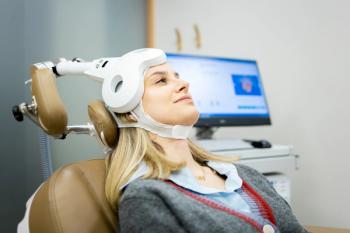
New Answers for Treatment-Resistant Depression
It is much easier to treat depression after 6 months of non-response than 6 years, regardless of which intervention is used, so time is of the essence.
RESEARCH UPDATE
Treatment-resistant depression (TRD) is a category that is all-too-easy to fall into. A lack of meaningful response to two full antidepressant trials is all it takes, and 1 in 3 patients with depression end up there. Once they do, the path out is uncertain. We have two FDA-approved therapies for TRD: olanzapine/fluoxetine combination (Symbyax, approved in 2009) and intranasal esketamine (Spravato, approved in 2019).
Beyond that, most research on TRD used a looser definition: failure of just one trial (also known as Stage I TRD in the Thase-Rush Staging Method). That was how transcranial magnetic stimulation (TMS) got approved and how the majority of antidepressant augmentation studies have been conducted.For example, in a 2015 meta-analysis of TRD, three quarters of the studies included patients who had only failed one antidepressant, and half of them focused
A new meta-analysis set out to address this gap by focusing only on studies of true TRD with at least two failed antidepressants. They arrived at some surprising results which I’ll review here.
The new study
Led by Allan Young, the British and Canadian researchers gathered 27 medication trials and 3 psychotherapy trials and analyzed the data 2 different ways. First by comparing the change in depressive symptoms with each treatment (the pre- post- effect size), and then through a network meta-analysis that
They found a significant benefit with the atypical antipsychotics, specifically (number of trials are in parentheses): aripiprazole (5), brexpiprazole (5), cariprazine(1), olanzapine (combined with fluoxetine) (1), and quetiapine (2). All of those are FDA-approved as antidepressant augmentation except cariprazine, which only worked in 2 out of 3 of its published
Lithium, which performed well as an
The novel finding in this analysis was the large effect of glutamatergic therapies: ketamine (3) and two repurposed antibiotics, minocycline (1) and d-cycloserine (1). When lumped together, their effect size was large (0.9), compared to the small effect size (0.2) of the atypical antipsychotics. This finding supports the glutamatergic system as a target for difficult to treat depressions, with a few caveats.
First, mechanisms of action are rarely clear, and it is possible that these medications exert their effects through other pathways.
Second, ketamine’s benefits are rapid but short-lived. After 1 week, its safety and efficacy are
The large effect in the glutamatergic category was not limited to ketamine but was shared by the novel agents minocycline and d-cycloserine as well. Each of these, however, was supported by only one small trial in true TRD.13,14 Of the two, minocycline is better studied, with 18 randomized controlled trials in depression which─when analyzed together─also yielded a large effect size (0.78).7 All of those studies were small, but a
When to use psychotherapy
With each failed treatment, life’s problems multiply. Relationships grow strained, job performance declines, and avoidant behaviors become further ingrained. It should not come as a surprise then that psychotherapy works in TRD, but the magnitude of that effect is unexpected. In Young’s analysis, psychotherapy had a slightly larger effect than pharmacotherapy in TRD. Those therapies were cognitive behavioral therapy (CBT) for 6 weeks, mindfulness based CBT for 8 weeks, and psychoanalytic psychotherapy, delivered weekly over 1.5 years.
The caveat here is that it is very difficult to compare treatments across different studies with different types of placebos, but the message is clear. Psychotherapy is not just for mild depression, but has proven its worth in moderate-severe depression, chronic depression, and─with these three recent trials─stage II TRD.
Limitations
Network meta-analyses have many limitations. Chief among them is the assumption that all of these trials share a common placebo effect. The “placebo,” however, is not a sugar pill, but an amalgam of varied factors including hope, the kind attention of the research team, and the natural course of the illness. If these effects were small, this wouldn’t be a big deal, but they are not. They account for around 30% of the improvement in antidepressant trials.
The bottom line
Young’s work digs up some new tools for TRD, but it also reveals how limited the TRD toolbox is. Novel medications had large effects but limited track records, while established therapies had only small effect sizes. Electroconvulsive therapy (ECT) was left out of the analysis, but even this gold standard becomes less likely to work with each failed medication trial, starting with the first one.16 Time is of the essence here. It is much easier to treat depression after 6 months of non-response than 6 years, regardless of which intervention is used.
When you set out on this work, bring the toolbox, but also bring a compass and a map (ie, a
Dr Aiken is the Mood Disorders Section Editor for Psychiatric Times, the Editor in Chief of
References
1. Zhou X, Ravindran AV, Qin B, et al.
2. Carter B, Strawbridge R, Husain MI, et al.
3. Strawbridge R, Carter B, Marwood L, et al.
4. Fava M, Durgam S, Earley W, et al.
5. Papadimitropoulou K, Vossen C, Karabis A, Donatti C, Kubitz N.
6. Rosenblat JD, McIntyre RS.
7. Perez-Caballero L, Perez V, Berrocoso E.
8. Xu Y, Hackett M, Carter G, et al.
9. Zheng W, Cai DB, Xiang YQ, et al.
10. Fedgchin M, Trivedi M, Daly EJ, et al.
11. Ochs-Ross R, Daly EJ, Zhang Y, et al.
12. Canuso CM, Singh JB, Fedgchin M, et al.
13. Heresco-Levy U, Gelfin G, Bloch B, et al.
14. Husain MI, Chaudhry IB, Husain N, et al.
15. Husain MI, Cullen C, Umer M, et al.
16. Dombrovski AY, Mulsant BH, Haskett RF, Prudic J, Begley AE, Sackeim HA.
Newsletter
Receive trusted psychiatric news, expert analysis, and clinical insights — subscribe today to support your practice and your patients.











